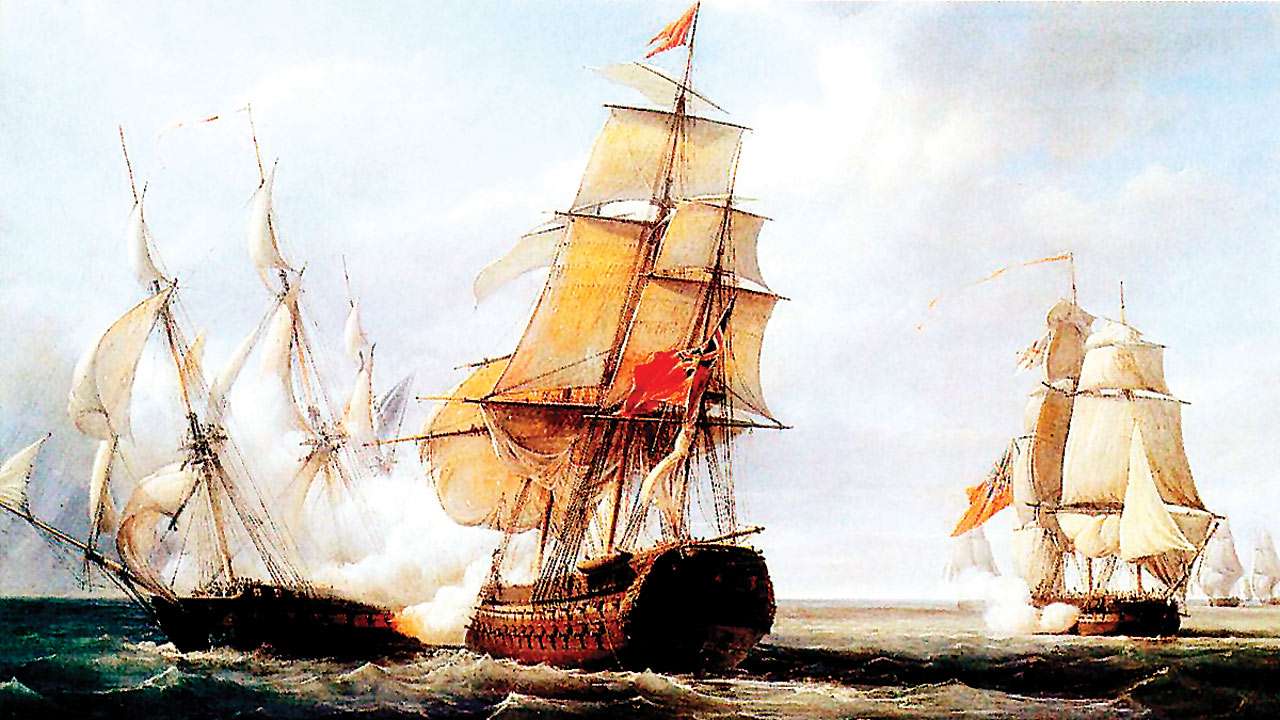
Way back in 1736, the East India Company granted a few ship building contracts to an enterprising Parsi named Lovji Nussarwanjee Wadia. The British had barely shown their presence in India’s politics, but they were in firm control of what is today’s Mumbai city, minus its suburbs. The Marathas were the paramount power with Peshwa Bajirao still around. The East India Company and the Wadias laid the foundations of something that would outlast the East India Company, the Maratha empire and the British empire itself — the Bombay Docks (now the Naval dockyard). From the start of 1736 till many years later, the Wadias built over a hundred ships of Malabar teak. In fact, the dry dock built in 1750 is still in use; it was Asia’s first dry dock.
The Duncan Dock, named after Bombay’s Governor Jonathan Duncan, was built around 1808, and at the time of construction, was the largest dock in the world outside Europe. Although designed in London, it was built entirely by the Wadias. In June 1810, Jamshedji Bomanji Wadia built and launched a ship called the HMS Minden (His Majesty’s Ship) at this dock. The ship was named after a town in Germany where the British had battled the French back in 1759. It was the first battleship built at the Bombay Docks to be directly commissioned into the British Royal Navy, built under contract for the British Admiralty. That is quite a compliment to Indian shipbuilding quality and skills. Built at a cost of Rs five lakh, it was a fully rigged sailing ship with up to 74 guns. Says the Bombay Courier, a contemporary newspaper, “The HMS Minden, for beauty of construction and strength of frame, may stand in competition with any man of war that has come out of the finest docks of Great Britain.” The Duncan Dock is still used for small vessels and submarines of the Indian Navy.
Early in 1811, the Minden sailed from Bombay to Madras, before heading to the Java islands and Batavia (now Indonesia) to fight its first few battles. The India-built HMS Minden managed to defend itself quite well against the Dutch and the French at Batavia before it sailed for the United Kingdom. From here it sailed to South Africa as also the Caribbean.
Halfway around the globe from India, England was busy battling the United States. Although Independence had been gained in 1776, issues over maritime rights lingered and politicians in the USA believed this was a good time to press the matter by attacking Canada, which was then under British control, as also Florida, ruled by Britain’s ally Spain.
Around this time, much of Britain’s naval fleet were engaged in fighting with Napoleon Bonaparte. With Napoleon defeated at Waterloo in 1814, scores of British ships and soldiers sailed west towards USA.
The British decided to set an example by destroying Fort McHenry at Baltimore, a city on the eastern coast of USA. It originally did not have a large enough flag atop it, hence a new one was commissioned. It was duly stitched by a woman named Mary Young Pickersgill. Consisting of 15 stars and 15 stripes, it came to be called the ‘Star Spangled Banner’. The United States consisted of 15 states in 1814, and the flag reflected it.
Now, back to the HMS Minden. This ship formed part of the fleet that was sent to attack Baltimore. An American lawyer and part time poet, Francis Scott Key, was aboard this ship. Of course, writing a poem wasn’t his main job there; he had accompanied the British Prisoner Exchange Agent named Col. John Skinner to try and secure the release of some Americans who had been taken prisoner in Maryland by the British. During their stay on board the ship, they came to know of British plans to bombard Baltimore and capture Fort McHenry. Unfortunately for them, the British too sensed the same, and their visit on the HMS Minden turned out to be a case of house arrest.
The British Navy commenced its bombarding of Baltimore that same night, leaving Francis Scott Key helpless, as he watched his hometown get bombed. But by the first light of dawn, a most unexpected sight met his eyes: The American flag was still flying atop Fort McHenry. It had not been replaced by the Union Jack. It was a good thing that an extra-large flag had been stitched, else Key would have never managed to spot it from such a distance. An inspiring moment indeed, which made him pen down a few lines of a new poem titled ‘The Defence of Fort McHenry’. Soon afterwards, he completed the poem at a hotel called the Indian Queen! It was renamed ‘The Star Spangled Banner’ a few months later and following great popularity in the next 100-odd years, it was officially made the USA’s National Anthem in 1931.
Although few accounts state that the ship in question was the HMS Tannon, the vast majority, including a book on Bombay Docks written by a Wadia himself, concur that it was the HMS Minden. The ship itself had a long life after this battle, being engaged in Algiers, Malta, Trincomalee etc. It became a hospital ship off the coast of Hong Kong in 1842, and remained so for five years. Its last 15 years were spent shipping stores for various naval vessels.
Finally, in 1861, the ship was retired and scrapped. Its Malabar teak had lasted over 50 years of salt water and rough seas.
This then was the HMS Minden — a modern battleship built in India, and on which by pure chance, the composer of USA’s National Anthem found himself. One of history’s most interesting coincidences!
The writer is the author of Brahmaputra — Story of Lachit Borphukan and Sahyadris to Hindukush — Maratha Conquest of Lahore and Attock. Views expressed are personal.